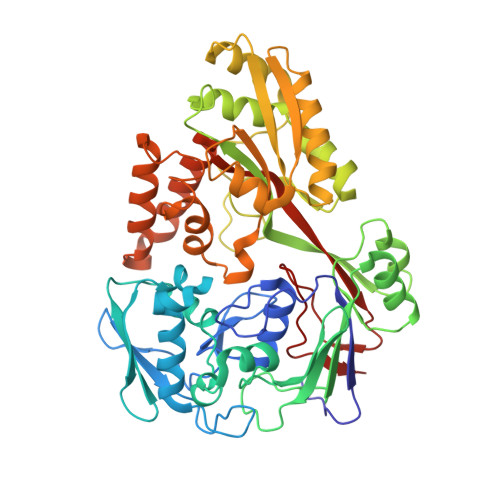Molecular characterization of the interaction of sialic acid with the periplasmic binding protein fromHaemophilus ducreyi.
Gangi Setty, T., Mowers, J.C., Hobbs, A.G., Maiya, S.P., Syed, S., Munson Jr., R.S., Apicella, M.A., Subramanian, R.(2018) J Biol Chem 293: 20073-20084
- PubMed: 30315109
- DOI: https://doi.org/10.1074/jbc.RA118.005151
- Primary Citation of Related Structures:
5YYB, 5Z99, 5ZA4 - PubMed Abstract:
The primary role of bacterial periplasmic binding proteins is sequestration of essential metabolites present at a low concentration in the periplasm and making them available for active transporters that transfer these ligands into the bacterial cell. The periplasmic binding proteins (SiaPs) from the tripartite ATP-independent periplasmic (TRAP) transport system that transports mammalian host-derived sialic acids have been well studied from different pathogenic bacteria, including Haemophilus influenzae , Fusobacterium nucleatum , Pasteurella multocida , and Vibrio cholerae SiaPs bind the sialic acid N -acetylneuraminic acid (Neu5Ac) with nanomolar affinity by forming electrostatic and hydrogen-bonding interactions. Here, we report the crystal structure of a periplasmic binding protein (SatA) of the ATP-binding cassette (ABC) transport system from the pathogenic bacterium Haemophilus ducreyi The structure of Hd -SatA in the native form and sialic acid-bound forms (with Neu5Ac and N -glycolylneuraminic acid (Neu5Gc)), determined to 2.2, 1.5, and 2.5 Å resolutions, respectively, revealed a ligand-binding site that is very different from those of the SiaPs of the TRAP transport system. A structural comparison along with thermodynamic studies suggested that similar affinities are achieved in the two classes of proteins through distinct mechanisms, one enthalpically driven and the other entropically driven. In summary, our structural and thermodynamic characterization of Hd-SatA reveals that it binds sialic acids with nanomolar affinity and that this binding is an entropically driven process. This information is important for future structure-based drug design against this pathogen and related bacteria.
Organizational Affiliation:
From the Institute for Stem Cell Biology and Regenerative Medicine, GKVK Post, Bangalore 560065, India,; the University of Trans-Disciplinary Health Sciences and Technology (TDU), Bengaluru, Karnataka 560064, India.














